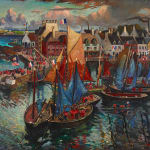Richard Hayley Lever 1876-1958
Framed dimensions: 44 1/2 x 54 inches
Lever moved to New York City in 1911, reportedly at the suggestion of the American painter Ernest Lawson, whom he might have met in Paris in 1893. Both artists shared a love of painting cityscapes and the countryside and both developed a spontaneous, daring method of working. Lever soon became friends with those in Lawson’s circle, including Robert Henri, William Glackens, John Sloan and George Bellows, and they exhibited together at the Whitney Studio Club, Macbeth Gallery, and Kraushaar Gallery.
Concarneau (Quatorze Juillet), executed before Lever moved to the States, is one the brilliant harbor scenes he painted in and around St. Ives, Cornwall, where he lived (Concarneau is directly across the English Channel). Lever's distinctive style of bold color and strong lines reveal the influence of Vincent van Gogh. The contrasting color of the thickly applied paint create a dynamic physical surface that enliven the already energetic composition. Lever wrote, "Art is the re-creation of mood in line, form and color. If I were confined to my own back yard for the rest of my life, I'd still have more pictures in my mind than I would have time to paint. Art is nothing but having a good time." Indeed, there is joyful playfulness to Lever's paintings, and this depiction of Concarneau is the artist at his best.
Provenance
Clayton-Liberatore Gallery, Bridgehampton, New York;
Private collection, New York;
Sale, Sotheby’s, New York, New York, November 29, 2006, lot 71, from above;
David Dike Fine Art, Dallas, Texas;
James E. Sowell, Dallas, Texas;
Private collection, New York, New York;
Questroyal Fine Art, New York;
Private collection, Pennsylvania to present
Exhibitions
Carnegie Museum of Art, Pittsburgh, Pennsylvania, c. 1911



